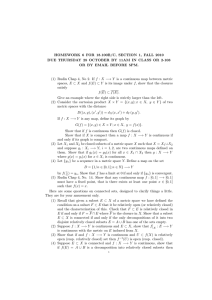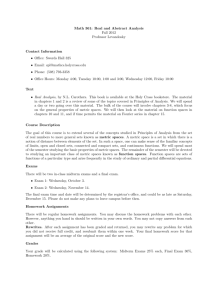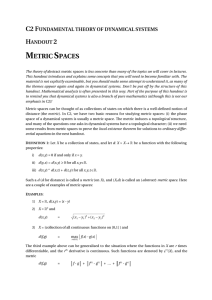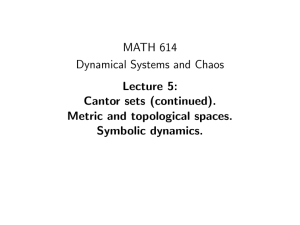Problems from Carothers, Real Analysis (CUP 2000). Ch. 5
advertisement
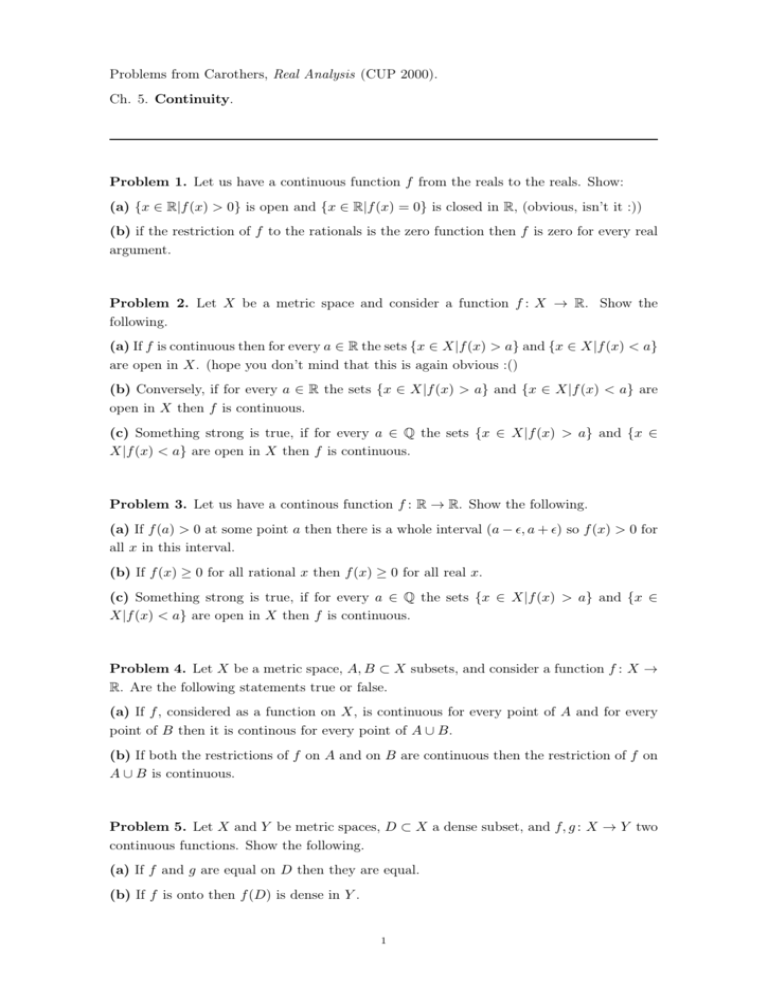
Problems from Carothers, Real Analysis (CUP 2000).
Ch. 5. Continuity.
Problem 1. Let us have a continuous function f from the reals to the reals. Show:
(a) {x ∈ R|f (x) > 0} is open and {x ∈ R|f (x) = 0} is closed in R, (obvious, isn’t it :))
(b) if the restriction of f to the rationals is the zero function then f is zero for every real
argument.
Problem 2. Let X be a metric space and consider a function f : X → R. Show the
following.
(a) If f is continuous then for every a ∈ R the sets {x ∈ X|f (x) > a} and {x ∈ X|f (x) < a}
are open in X. (hope you don’t mind that this is again obvious :()
(b) Conversely, if for every a ∈ R the sets {x ∈ X|f (x) > a} and {x ∈ X|f (x) < a} are
open in X then f is continuous.
(c) Something strong is true, if for every a ∈ Q the sets {x ∈ X|f (x) > a} and {x ∈
X|f (x) < a} are open in X then f is continuous.
Problem 3. Let us have a continous function f : R → R. Show the following.
(a) If f (a) > 0 at some point a then there is a whole interval (a − , a + ) so f (x) > 0 for
all x in this interval.
(b) If f (x) ≥ 0 for all rational x then f (x) ≥ 0 for all real x.
(c) Something strong is true, if for every a ∈ Q the sets {x ∈ X|f (x) > a} and {x ∈
X|f (x) < a} are open in X then f is continuous.
Problem 4. Let X be a metric space, A, B ⊂ X subsets, and consider a function f : X →
R. Are the following statements true or false.
(a) If f , considered as a function on X, is continuous for every point of A and for every
point of B then it is continous for every point of A ∪ B.
(b) If both the restrictions of f on A and on B are continuous then the restriction of f on
A ∪ B is continuous.
Problem 5. Let X and Y be metric spaces, D ⊂ X a dense subset, and f, g : X → Y two
continuous functions. Show the following.
(a) If f and g are equal on D then they are equal.
(b) If f is onto then f (D) is dense in Y .
1
Real Analysis
problem set
(AUBG Fall’11)
Problem 6. Let X and Y be topological spaces and f : X → Y a function. Show the
continuity of f is equivalent to either one of the following.
(a) If f (A¯) ⊂ (f (A))¯for any A ⊂ X (recall that A¯denotes closure).
(b) If f −1 (B o ) ⊂ (f −1 (B))o for any B ⊂ Y (recall that B o denotes interior).
Problem 7. Let X and Y be topological spaces and f : X → Y a function.
(a) If {Un }∞
n=1 is an open cover of X and f |Un is continuous for every n show that f is
continuous.
(b) If X = ∪kn=1 Fn with F1 , . . . , Fk closed and f |Fn is continuous for n = 1, . . . , k show
that f is continuous.
(c) Show that if in (b) above we use a countable union of closed sets then f need not be
continuous.
Problem 8. Let X be a metric space and U ⊂ X a open subset.
(a) Show that there exists an continuous function f : X → R and an open set V ⊂ R such
that U = f −1 (V ).
(b) Do we need to have a metric on X or a topology is enough .
Problem 9. Let X be a metric space, (xn ) a sequence in X, and x ∈ X a point. Assume
that for every continuous function f : X → R the we have limn→∞ f (xn ) = f (x). Can we
conclude that xn converges to x?
Problem 10. Let (X, d) be a metric space. For two subsets A, B ⊂ X define the distance
between them to be d(A, B) = inf a∈A,b∈B d(a, b). Give an example of two disjoint closed
sets A and B such that the distance between them is zero.
Hint: Take X to be the plane and draw a picture .....................................
Problem 11. Assume a function f : R → R is given which is additive, i.e., f (x + y) =
f (x) + f (y) holds for all x, y ∈ R.
(a) Show that f (0) = 0 and that f (−x) = −f (x) for all x, y ∈ R.
(b) Show that if f is continuous at x = 0, then f is continuous at every point in R.
(c) Denote a = f (1). Show first that f (n) = an for all n ∈ Z and then that f (r) = ar for
any rational number r.
(d) Show that if f is continuous then f (x) = ax for all real x. (Compare with problem 5.)
Thus, any additive function that is continuous at x = 0 must necessarily be a linear
function through the origin.
2








